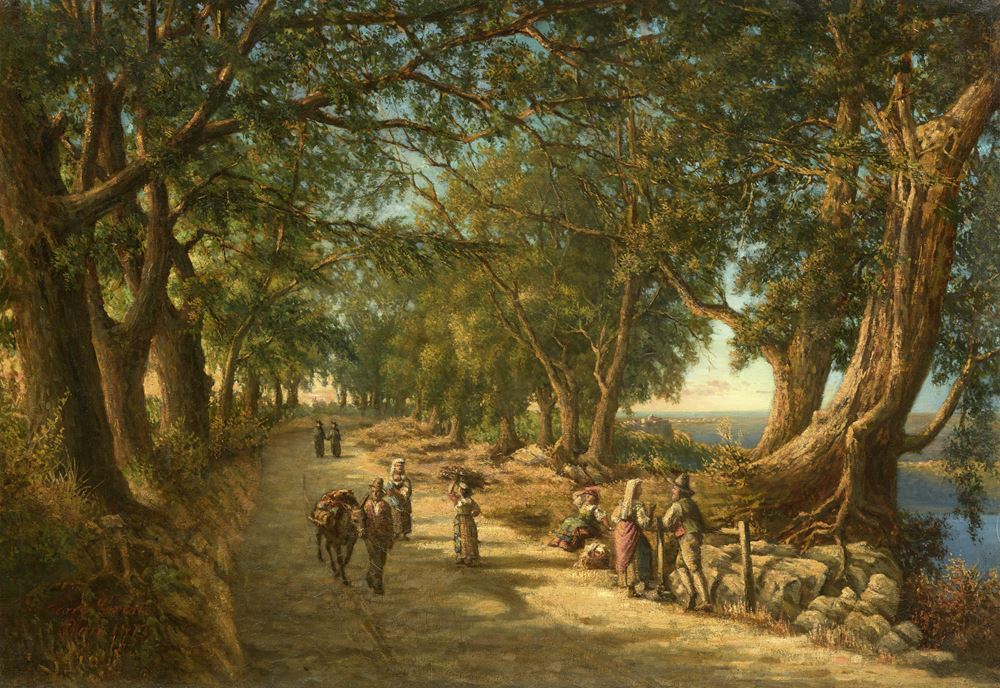
Lotto 3237* - A204 Dipinti del XIX secolo - venerdì, 31. marzo 2023, 16h00
JOHANN GEORG GRIMM
European private collection.
Exhibited:
Mindelheim 2022, Auf und Davon. Vom Allgäu in die weite Welt. Georg Grimm (1846–1887). Mindelheimer Museen, 24.6.2022–16.10.2022.
Johann Georg Grimm is regarded as the pioneer of plein-air painting in Brazil and the founding father of Brazilian landscape painting of the 19th century. His topographical views of the country are amongst the most sought-after examples of painting from this region.
Grimm, a talented draughtsman from the Allgäu, was the son of a carpenter and first trained as a carpenter himself before finally embarking on an apprenticeship as a painter. Due to work commitments, he travelled via Kempten and Neustift to Munich, where he was accepted into the Academy of Fine Arts in 1867. Despite financial constraints, he spent three years at the Academy in Munich and it was probably during this time that he met his future patroness, the art-loving surgeon’s wife Therese Carolina Ravoth. In Ravoth, Grimm, who had already lost his mother as a young boy, not only found a generous benefactor – she probably financed Grimm's study trip to Italy – but also a mother figure with whom he maintained correspondence until his death.
This early work by the Allgäu artist is one of the first large-format commissions he executed. The signature and date ‘Georg Grim, Rom 1873’ place the painting in the period of Grimm's first European tour. It is therefore the only large-format painting known to date from the period between 1872 and 1875. During his stay in Rome, Grimm wrote in a letter to his brother that he had been able to sell a painting to his Berlin patroness. Considering the date when it was painted, it is quite possible that this is the work in question.
Grimm’s ‘Grand Tour’ lasted from 1872 to 1875. First, he travelled through Italy and visited Rome, Florence and Capri several times, occasionally in the company of Therese Ravoth's son, Max Ravoth, who was also on his Grand Tour. After a brief stopover in Berlin, he continued his journey until 1877, travelling via Sicily through the Orient and the Maghreb to France, England and finally to Portugal, where in Lisbon, no doubt fascinated by the exotic, he unexpectedly decided to set sail for Brazil. For the next two years, Grimm spent time in the provinces surrounding Rio de Janeiro, painting detailed pictures for the wealthy landowners of their coffee plantations and other estates (see ill.1, taken from the exhibition catalogue Johann Georg Grimm 1846–1887. Künstlerkarriere zwischen Allgäu und Brasilien, Immenstadt 2006, p. 16).
Grimm then briefly returned to his homeland in 1880 and, after the death of his father, travelled through Europe for a second time before returning to Brazil in 1881. Back in Brazil, Grimm took part in a public art exhibition organised by the Sciedade Propagadora das Belas Artes in Rio de Janeiro. Grimm enjoyed great success with his works, most of which had been produced during his travels through Europe and was awarded the gold medal. Much praised by the press, he was finally appointed professor of landscape painting at the Academia Imperial de Belas Artes at the personal intervention of the Brazilian Emperor Pedro. At the academy, he gathered around him a circle of highly talented emerging artists, who at the beginning of the 20th century were among the most brilliant generations of painters in Brazil. Passionate about painting in the great outdoors, Grimm taught a light-filled plein-air style of painting, like his great predecessors of the Barbizon School, and revolutionised the Academy's teaching methods.
In 1884, as Grimm did not renew his contract of employment at the Academy, he moved with his students and friends to the city of Niteroi, where they continued to engage in open-air painting. The circle of artists around Grimm, later known as ‘O grupo Grimm’, had a strong influence on the artistic scene in Brazil at that time and generated a significant impetus towards modernism in the region.
After the group disbanded, Grimm moved on through the provinces of Rio de Janeiro and Minas Gerais. While working on one of his commissions, Grimm contracted tuberculosis and travelled back to Europe, where he sought medical treatment. After spending several weeks in Wengen, Switzerland with his brother, he travelled on to Sicily, which had a more favourable climate, and eventually died in Palermo in 1887.
CHF 20 000 / 30 000 | (€ 20 620 / 30 930)
Venduto per CHF 18 600 (incl. premio dell'acquirente)
Non si assume alcuna responsabilità per la correttezza di queste informazioni.


